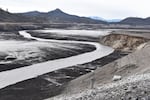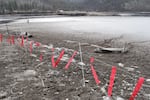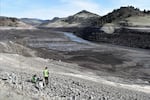
The Klamath River flows through what was the Copco Lake Reservoir.
Juliet Grable / JPR
Iron Gate, the lowest of the Klamath dams, was breached first on Jan. 9, followed by J.C. Boyle in Oregon, and finally, Copco 1. Draining the three reservoirs marks another milestone toward the removal of dams in the Lower Klamath Project.
“A lot of sediment mobilized and moved through the system, exactly according to our plans and our projections,” said Mark Bransom, CEO of Klamath River Renewal Corporation, during a press conference on Thursday morning. “We’re very pleased with the progress that has been made on the drawdown.”
In total, KRRC expects 5 to 7 million cubic yards of sediment — the same amount that the Klamath River would normally drain in a single year — to wash downstream over a short period of time. The material, composed mostly of very fine silt and dead algae, has imbued the river with a dark coffee color.
For several days last week, dissolved oxygen levels in the first 20 miles below Iron Gate dam hovered close to zero. Decomposing algae rob water of oxygen, as do oxidizing minerals. As the last of the reservoirs drained, they released oxygen-poor water, as well.
“The bottom of reservoirs have this anoxic layer — this layer of water that basically doesn’t have any oxygen in it,” explained Desiree Tullos, professor of water resources engineering at Oregon State University.
Related: Residents saddened by loss of Copco Lake amid Klamath dam removal
The river becomes re-aerated as it tumbles over rocks; major tributaries like the Shasta River also bring in oxygenated water to the mainstem of the Klamath River. “The farther away you get away from the reservoirs, the less and less impact you’ll have,” said Tullos.
Experts expected oxygen levels to dip, which is why drawdown was initiated in the winter months.
“We don’t have adult salmon in the river system, and most of the juveniles are up in the tributaries and have not yet started their out-migration to the ocean,” said Bransom.
The draining of the reservoirs has left behind large “mudscapes,” especially in the broader Copco Lake footprint. In late January, nearly a dozen deer became entrapped in the mud and perished around the former reservoir. California Department of Fish and Wildlife has since installed fladry — strings of small flags that flap in the breeze to dissuade animals — at several locations.

Flagging set up around the former Copco Reservoir to deter wildlife from deep mud.
Juliet Grable / JPR
Thousands of fish that inhabited the reservoirs have also died. These are mostly non-native species, including yellow perch, crappie, and bass that thrive in calmer, warmer water.
“It was always expected that these species would not persist,” said Dave Coffman, geoscientist for Resource Environmental Solutions, or RES, during the press conference.
Related: Fourth dam breached on the Klamath River
Concerns over water quality
During a tense and lengthy public meeting on Feb. 13, several area residents expressed concerns about the entrapped animals and scores of dead fish, wells that have gone dry in the Copco Lake community, and the possibility of contaminated sediment being exposed and making its way downstream.
William Simpson, founder and CEO of the nonprofit Wild Horse Fire Brigade who lives near Yreka, California, referenced test results of a sample collected by one of his neighbors in late January that revealed elevated levels of several metals, including chromium.
“It’s shocking that you even bring up the whole idea of water quality when the only testing really going on is turbidity, flow and oxygen, when you have all these other things that need to be considered, which we know are in the sediment,” said Simpson, who has been publishing strongly worded op-eds in Siskiyou News criticizing KRRC and dam removal.
Coffman cautioned against jumping to conclusions about Simpson’s water test results without knowing more about how it was collected, how it was taken care of, and whether or not it was filtered.
“There’s not enough information associated with it for it to be useful,” said Coffman, adding that more than a decade of work went into evaluating the effects of dam removal on state waters. “That [work] included a lot of sediment and water quality testing on the stuff that’s impounded within the reservoirs.”
Related: Massive dam removal project spurs hope in the Klamath Basin
As part of the permitting process for removing the dams, KRRC developed a water quality monitoring plan. It includes continuous monitoring using permanently installed U.S. Geological Survey gages from above J.C. Boyle to the river mouth; regular “grab samples” of river water that are analyzed for cyanotoxins and nutrients like phosphorus; and sediment sampling.
Sediment samples collected from around the former reservoirs and from deposits downstream later this year will be tested for particulate metals, but none of the water samples are being tested for dissolved metals, said Coffman. “Typically, we don’t see dissolved metal issues in surface runoff dominated systems like the Klamath River,” he explained, adding that previous studies, most recently contracted by the U.S. Environmental Protection Agency in 2020, did not raise concerns that any metals or contaminants would harm aquatic life or people’s use of the river.
“That monitoring will continue for years beyond now to evaluate the temporary detrimental or negative impacts, but also the long-term recovery of the river,” said Coffman.
Meanwhile, the Siskiyou County Board of Supervisors and Chief Administrative Officer asked Siskiyou County Environmental Health to “fill some gaps” in water quality testing. The department has begun sampling water at six sites along the river from just below Iron Gate dam to the town of Happy Camp, California. The first round of samples, taken Jan. 31, were tested for heavy metals. At the sites closest to the dams, concentrations of iron, aluminum, lead, and arsenic were above U.S. EPA drinking water standards.
Related: No turning back: The largest dam removal in US history begins
At the public meeting, Rick Dean, community development director for Siskiyou County, cautioned that the drinking water standard is typically used to evaluate water from private wells and other potable water sources and is not the ideal metric for evaluating the quality of “surface waters” like rivers and lakes.
Farther from the dams, in the Mid-Klamath section of the river, concentrations of all metals except aluminum and iron fell below the drinking water standard, said Dean, attributing the lower concentrations further away from the dams “primarily due to dilution.”
Additional samples collected on Feb. 6 are being tested for 49 constituents, including known carcinogens like dioxins and polychlorinated biphenyls, or BCPs. The results will be posted on the county’s website, and they will continue testing on a quarterly basis.
In an email to JPR, Dean stressed that conditions on the river right now are dangerous. “The river is extremely turbid with low to no visibility, [and] sediment discharge has created pockets of thick sediments that present entrapment danger to wildlife [and] livestock as well as humans,” he wrote. “River water is not fit for consumption.”

OSU researchers stand on the edge of the former Iron Gate Reservoir with the Klamath River below.
Juliet Grable / JPR
Sprouts in the sediment
On Jan. 15, crews from the Yurok Tribe contracted by RES began planting native seeds in the reservoir footprints.
“Right now, crews are focused on Copco and Iron Gate,” said Coffman. “Access is improving every day as these sediments continue to dry out, so we’re chipping away at the acreage.”
To date, they’ve seeded about 400 acres, hand sowing with special seed mixes tailored for each site. Crews have planted over 27,000 acorns and 14,000 bare-root container plants.
Related: Researchers, tribes, residents prepare for a century of sediment released from the Klamath dams
Crews are not yet working at the former Topsy reservoir, behind J.C. Boyle dam in Southern Oregon. This reservoir footprint is higher and wetter than the other two, so RES will have a longer window for planting there.
In a few weeks, RES will begin seeding via helicopter to ensure all of the acreage is covered while the ground is still wet enough to induce germination. Already, tiny plants are beginning to emerge around the former reservoirs.
After final drawdown is complete later this spring, deconstruction of the three remaining dams will begin more or less simultaneously, starting in June. If all goes according to plan, the obstacles will be completely gone by September or October, giving salmon the chance to reach tributary creeks above the former dam sites this fall.